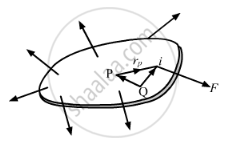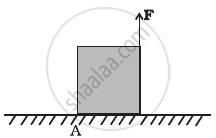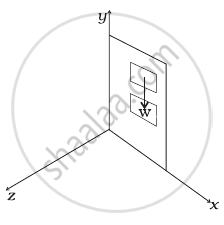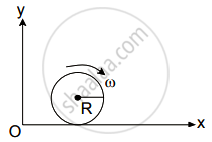Advertisements
Advertisements
प्रश्न
A body is in translational equilibrium under the action of coplanar forces. If the torque of these forces is zero about a point, is it necessary that it will also be zero about any other point?
उत्तर
Yes , if the torque due to forces in translation equillibrium is zero about a point, it will be zero about other point in the plane.

Let us consider a planner lamina of some mass, acted upon by forces \[\overrightarrow{F_1}, \overrightarrow{F_2}, . . . \overrightarrow{F_i},\] etc.
Let a force \[\overrightarrow{F_i}\] act on a \[i^{th}\] particle and torque due to \[\overrightarrow{F_i}\] be zero at a point Q.
Since the body is in translation equillibrium, we have
\[\Sigma \overrightarrow{F_i} = 0 .............(1)\]
Again, torque about P is zero . Therefore, we have
\[\Sigma\left( \overrightarrow{r_{pi}} \times \overrightarrow{F_i} \right) = 0 ..............(2)\]
Now, torque about point Q will be
\[\Sigma \overrightarrow{r}_{Qi} \times \overrightarrow{F_i} \]
\[ = \Sigma\left( \overrightarrow{r}_{QP} + \overrightarrow{r}_{Pi} \right) \times \overrightarrow{F_i} ............\left[\text{From fig.} \right]\]
\[ = \Sigma\left( \overrightarrow{r}_{QP} \times \vec{F_i} + \overrightarrow{r_{Pi}} \times \overrightarrow{F_i} \right)\]
\[ = \Sigma \overrightarrow{r_{QP}} \times \overrightarrow{F_i} + \Sigma \overrightarrow{r_{Pi}} \times \overrightarrow{F_i} \]
\[ = \overrightarrow{r_{QP}} \times \Sigma \overrightarrow{F_i} + 0 ..........\left[\text{From (2)} \right]\]
\[ = \overrightarrow{r_{QP}} \times 0 .........\left[\text{From (1)} \right]\]
\[ = 0\]
Thus, \[\overrightarrow{F}\] is zero about any other point Q.
APPEARS IN
संबंधित प्रश्न
Two particles, each of mass m and speed v, travel in opposite directions along parallel lines separated by a distance d. Show that the angular momentum vector of the two particle system is the same whatever be the point about which the angular momentum is taken.
Explain why friction is necessary to make the disc in Figure roll in the direction indicated
(a) Give the direction of frictional force at B, and the sense of frictional torque, before perfect rolling begins.
(b) What is the force of friction after perfect rolling begins?

The torque of a force \[\overrightarrow F \] about a point is defined as \[\overrightarrow\Gamma = \overrightarrow r \times \overrightarrow F.\] Suppose \[\overrightarrow r, \overrightarrow F\] and \[\overrightarrow \Gamma\] are all nonzero. Is \[r \times \overrightarrow\Gamma || \overrightarrow F\] always true? Is it ever true?
A particle of mass m is projected with a speed u at an angle θ with the horizontal. Find the torque of the weight of the particle about the point of projection when the particle is at the highest point.
Two discs of the same moment of inertia rotating about their regular axis passing through centre and perpendicular to the plane of the disc with angular velocities ω1 and ω2. They are brought in to contact face to face coinciding with the axis of rotation. The expression for loss of energy during this process is, ______
The ratio of the acceleration for a solid sphere (mass m and radius R) rolling down an incline of angle θ without slipping and slipping down the incline without rolling is, ______
Define torque and mention its unit.
State conservation of angular momentum.
A particle of mass 5 units is moving with a uniform speed of v = `3sqrt 2` units in the XOY plane along the line y = x + 4. Find the magnitude of angular momentum
A uniform cube of mass m and side a is placed on a frictionless horizontal surface. A vertical force F is applied to the edge as shown in figure. Match the following (most appropriate choice):

| (a) mg/4 < F < mg/2 | (i) Cube will move up. |
| (b) F > mg/2 | (ii) Cube will not exhibit motion. |
| (c) F > mg | (iii) Cube will begin to rotate and slip at A. |
| (d) F = mg/4 | (iv) Normal reaction effectively at a/3 from A, no motion. |
A door is hinged at one end and is free to rotate about a vertical axis (Figure). Does its weight cause any torque about this axis? Give reason for your answer.

Two discs of moments of inertia I1 and I2 about their respective axes (normal to the disc and passing through the centre), and rotating with angular speed ω2 and ω2 are brought into contact face to face with their axes of rotation coincident.
- Does the law of conservation of angular momentum apply to the situation? why?
- Find the angular speed of the two-disc system.
- Calculate the loss in kinetic energy of the system in the process.
- Account for this loss.
A spherical shell of 1 kg mass and radius R is rolling with angular speed ω on horizontal plane (as shown in figure). The magnitude of angular momentum of the shell about the origin O is `a/3 R^2` ω. The value of a will be:

A rod of mass 'm' hinged at one end is free to rotate in a horizontal plane. A small bullet of mass m/4 travelling with speed 'u' hits the rod and attaches to it at its centre. Find the angular speed of rotation of rod just after the bullet hits the rod 3. [take length of the rod as 'l']
Angular momentum of a single particle moving with constant speed along the circular path ______.
The magnitude of the torque on a particle of mass 1 kg is 2.5 Nm about the origin. If the force acting on it is 1 N, and the distance of the particle from the origin is 5 m, the angle between the force and the position vector is (in radians) ______.
A solid sphere is rotating in free space. If the radius of the sphere is increased while keeping the mass the same, which one of the following will not be affected?
